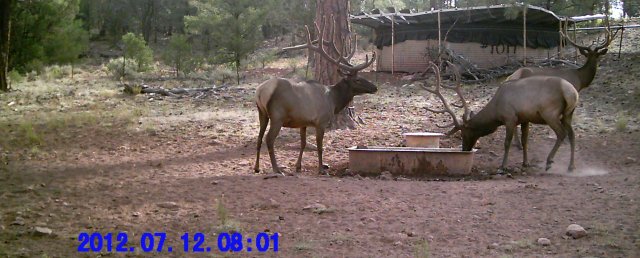Scouting with Trail Cameras
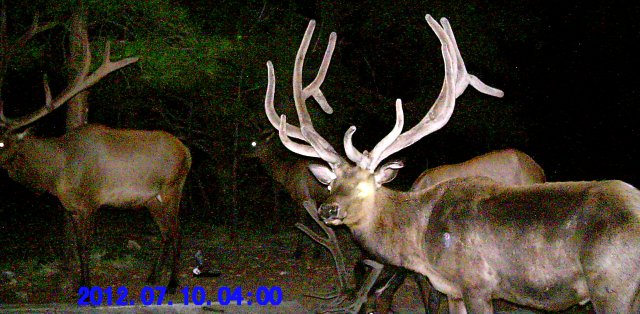
It’s that exciting time of year for elk lovers. The mature bulls are really looking great by now and giving us a real good indication of how big they will be this fall. I always say that you can tell by July 1st what a bull is going to be. If he’s a big one, you’ll know it! Whether you call them “Hammers”, “Pigs”, “Jumbos”, “Giants”, etc. these types of bulls are already showing some impressive racks. These big bulls just have some “tipping out” left to do.
Congratulations to those of you with limited entry elk tags for this fall or for those of you that plan to hunt in over the counter states and areas. For me, trail cameras have become an invaluable tool to aid in my scouting efforts. Besides being incredibly addicting and enjoyable, trail cameras can help you identity elk patterns, and give you an accurate barometer for antler growth each year. Here are some tips to help you have success by implementing trail cameras into your scouting.
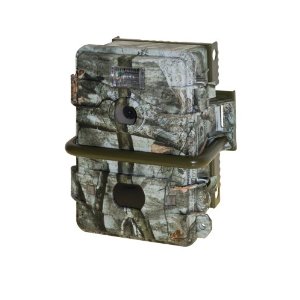 When I consider a quality trail camera, there are 6 things that come to mind.
When I consider a quality trail camera, there are 6 things that come to mind.
1. Durability
2. Ease of use & functionality
3. Range
4. Battery Life
5. Picture quality
6. Trigger Speed
I believe that for elk, trigger speed is the most over rated feature in a trail camera. Next, would be “infrared” or “black out” technology. The reason I say this is because when I set trail cameras up for elk, over 90% of the time I am either setting the cameras on water or on salt (Trophy Rock) since it is legal in Arizona. The most unpredictable place to set a camera is on a trail. By setting my cameras on water or Trophy Rock, I am taking advantage of the fact that the elk will spend lots of time in front of my cameras and give me lots of quality photos.
Many may find this unbelievable, but I have found by using cameras extensively for the past 5 years that elk are really not bothered by a flash at all. The proof is when you have the same elk standing in front of the camera for 30 minutes or more and they haven’t moved despite the flash going off dozens of times (see photos below and notice how the elk are not affected by the flash from minute to minute over a 25 minute period). When I first started out, I bought into the infrared rage and that is all I had, but over the years I have completely replaced them with flash cameras.
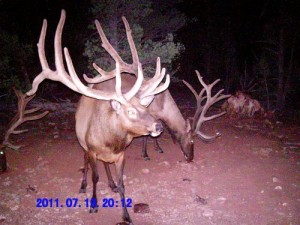
During the time that I used infrared cameras, I can remember many instances where I would spend hours going to check a camera that I had placed within 20 to 30 feet of water or salt, and it would have 1,500 to 2,000 photos on it. That got me very excited with anticipation, but of those photos, only 5 to 10 would be of an elk. All of the others were totally black! Talk about disappointing and frustrating.
So now that I am using the flash cams here is my routine for scouting with them. I start by putting out my Trophy Rock in early April if possible. That way, the bulls are able to utilize the minerals at the very beginning of their antler growing season all the way through early August when they will
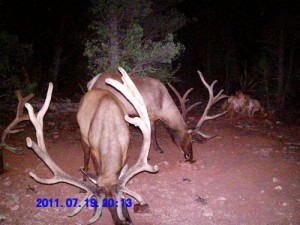 shed velvet. By establishing my “lick” sites early, it also ensures that the bulls will be locked into these sites so that I am apt to get lots of photos in the summer. I like to place lick sites near well used elk trails that go between water and bedding areas. I add Trophy Rock as needed usually adding blocks again in early July.
shed velvet. By establishing my “lick” sites early, it also ensures that the bulls will be locked into these sites so that I am apt to get lots of photos in the summer. I like to place lick sites near well used elk trails that go between water and bedding areas. I add Trophy Rock as needed usually adding blocks again in early July.
I prefer to wait to hang my cameras until late June to early July. This is when the bigger bulls are sporting full 6×6 (or better) racks and you can get some good photos. By waiting to hang cameras until then I avoid having full SD cards and dead batteries when it matters most.
My best results come by hanging my cameras 20’ to 30’ feet from the
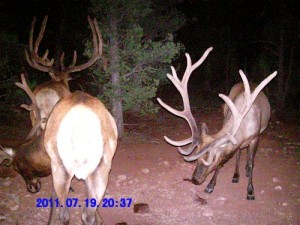 lick or the water source where I anticipate the elk to be. That way, you aren’t getting dark photos because the camera is too far or cutting off a big bull’s antlers by having it too close. Also very important is that I like to hang my cameras so that they are facing North or South. That way I am not getting either the sunrise or the sunset straight into the camera which can totally wash out your photos. I like to hang most of my cameras chest to head height. This seems to eliminate washed out pictures since the camera is not pointed up and into the skyline.
lick or the water source where I anticipate the elk to be. That way, you aren’t getting dark photos because the camera is too far or cutting off a big bull’s antlers by having it too close. Also very important is that I like to hang my cameras so that they are facing North or South. That way I am not getting either the sunrise or the sunset straight into the camera which can totally wash out your photos. I like to hang most of my cameras chest to head height. This seems to eliminate washed out pictures since the camera is not pointed up and into the skyline.
Don’t forget that your trail camera takes pictures due to motion. It can’t tell the difference between an elk and blowing vegetation. With this in mind, I try to choose locations where vegetation within 50’ of the camera is minimal or if that is not an option, I clear out the sources of movement so as not to fill my SD card with false pictures. My Leaf River Trail Cameras also have a very useful distance dial on them. I use this dial to very effectively adjust the distance so that the camera is not being set off by distant trees. By testing my cameras at home before going into the field I am able to experiment with the distance setting and dial it in perfectly for my scouting.
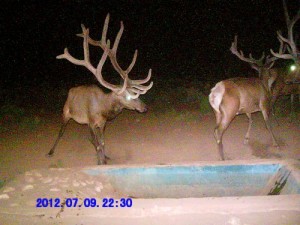 When hanging my cameras on a water source, I will typically set the camera to take 3 pictures per minute with a 1 minute delay. That way I don’t miss any big bulls that may come in and leave rather quickly. By contrast, when I hang a camera on Trophy Rock or salt, I am setting the camera to take 1 picture per minute with a 1 minute delay. Over the years I have learned that elk will spend A LOT of time at a lick and you don’t need 100 photos of the same bull on the same night!
When hanging my cameras on a water source, I will typically set the camera to take 3 pictures per minute with a 1 minute delay. That way I don’t miss any big bulls that may come in and leave rather quickly. By contrast, when I hang a camera on Trophy Rock or salt, I am setting the camera to take 1 picture per minute with a 1 minute delay. Over the years I have learned that elk will spend A LOT of time at a lick and you don’t need 100 photos of the same bull on the same night!
Lastly, is security. Unfortunately we all know that leaving a camera unlocked usually results in it walking away. A good security box is a necessary investment that will discourage thieves and also keep the bears from wrecking your cameras. If I am hanging cameras in an area that is free of bears and I am just trying to keep honest people honest, I don’t need a security box. In that instance, I use about 6’-8’ of chain to wrap around my camera and then around the tree. I secure the chain by using 2 locks that fit through the links of my chain (see photos). Oh, and don’t forget to turn your camera on before leaving it so you have photos when you return!
Most importantly, enjoy your time in the wonderful creation with your family and good friends. Good trail cam scouting and successful hunting to you!
